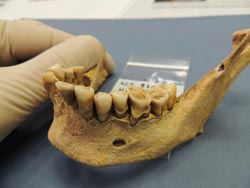Ancient Teeth Bacteria Record Disease Evolution

Photo by Alan Cooper, University of Adelaide<br> <br>Teeth of late Iron Age/Roman woman showing large dental calculus deposit, from Cambridge area, UK. <br>
The ancient genetic record reveals the negative changes in oral bacteria brought about by the dietary shifts as humans became farmers, and later with the introduction of food manufacturing in the Industrial Revolution.
An international team, led by the University of Adelaide’s Centre for Ancient DNA (ACAD) where the research was performed, has published the results in Nature Genetics today. Other team members include the Department of Archaeology at the University of Aberdeen and the Wellcome Trust Sanger Institute in Cambridge (UK).
“This is the first record of how our evolution over the last 7500 years has impacted the bacteria we carry with us, and the important health consequences,” says study leader Professor Alan Cooper, ACAD Director.
“Oral bacteria in modern man are markedly less diverse than historic populations and this is thought to contribute to chronic oral and other disease in post-industrial lifestyles.”
The researchers extracted DNA from tartar (calcified dental plaque) from 34 prehistoric northern European human skeletons, and traced changes in the nature of oral bacteria from the last hunter-gatherers, through the first farmers to the Bronze Age and Medieval times.
“Dental plaque represents the only easily accessible source of preserved human bacteria,” says lead author Dr Christina Adler, who conducted the research while a PhD student at the University of Adelaide, now at the University of Sydney.
“Genetic analysis of plaque can create a powerful new record of dietary impacts, health changes and oral pathogen genomic evolution, deep into the past.”
Professor Cooper says: “The composition of oral bacteria changed markedly with the introduction of farming, and again around 150 years ago. With the introduction of processed sugar and flour in the Industrial Revolution, we can see a dramatically decreased diversity in our oral bacteria, allowing domination by caries-causing strains. The modern mouth basically exists in a permanent disease state.”
Professor Cooper has been working on the project with archaeologist and co-Leader Professor Keith Dobney, now at the University of Aberdeen, for the past 17 years. Professor Dobney says: “I had shown tartar deposits commonly found on ancient teeth were dense masses of solid calcified bacteria and food, but couldn’t identify the species of bacteria. Ancient DNA was the obvious answer.”
However, the team was not able to sufficiently control background levels of bacterial contamination until 2007 when ACAD’s ultra-clean laboratories and strict decontamination and authentication protocols became available. The research team is now expanding its studies through time, and around the world, including other species such as Neandertals.
Photo caption:
Teeth of late Iron Age/Roman woman showing large dental calculus deposit, from Cambridge area, UK. Photo by Alan Cooper, University of Adelaide
Media Contact:
Professor Alan Cooper
Director, Australian Centre for Ancient DNA
The University of Adelaide
Phone: +61 8 8313 5950 / 8313 3952
Mobile: +61 406 383 884
alan.cooper@adelaide.edu.au
Robyn Mills
Media and Communications Officer
The University of Adelaide
Phone: +61 8 8313 6341
Mobile: +61 410 689 084
robyn.mills@adelaide.edu.au
Media Contact
More Information:
http://www.adelaide.edu.auAll latest news from the category: Life Sciences and Chemistry
Articles and reports from the Life Sciences and chemistry area deal with applied and basic research into modern biology, chemistry and human medicine.
Valuable information can be found on a range of life sciences fields including bacteriology, biochemistry, bionics, bioinformatics, biophysics, biotechnology, genetics, geobotany, human biology, marine biology, microbiology, molecular biology, cellular biology, zoology, bioinorganic chemistry, microchemistry and environmental chemistry.
Newest articles

Properties of new materials for microchips
… can now be measured well. Reseachers of Delft University of Technology demonstrated measuring performance properties of ultrathin silicon membranes. Making ever smaller and more powerful chips requires new ultrathin…

Floating solar’s potential
… to support sustainable development by addressing climate, water, and energy goals holistically. A new study published this week in Nature Energy raises the potential for floating solar photovoltaics (FPV)…

Skyrmions move at record speeds
… a step towards the computing of the future. An international research team led by scientists from the CNRS1 has discovered that the magnetic nanobubbles2 known as skyrmions can be…





















